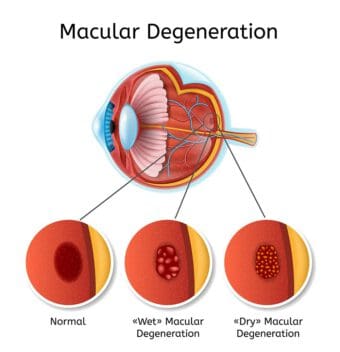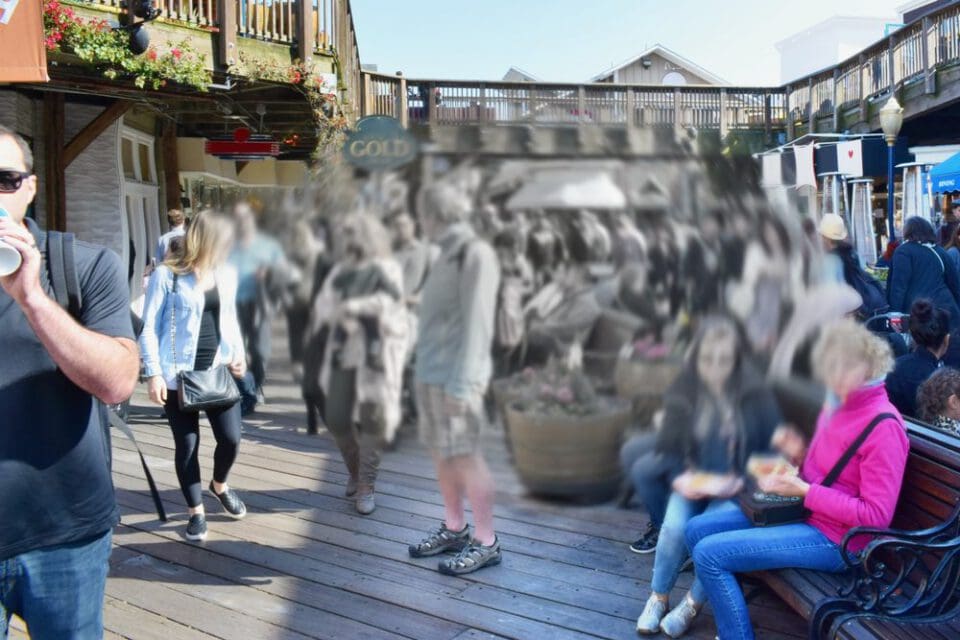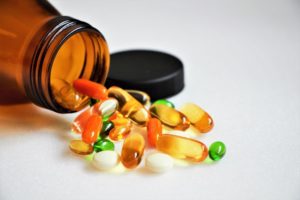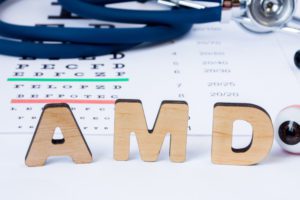Wet vs. Dry Macular Degeneration (AMD): What’s the Difference?
Last Updated:
Table of Contents
If you have age-related macular degeneration (AMD), you have one of two types: dry or wet AMD. Dry is more common and moves more slowly, caused by the buildup of drusen on the macula, leading to the death of photoreceptive cells there. Central vision loss and trouble with seeing well in dim light or darkness are the main signs of dry AMD. While there are not many medical treatments for dry AMD, the disease’s progress can be greatly slowed by making healthy lifestyle changes, especially adjusting vitamins and minerals in certain proportions.
Wet AMD is less common, but it moves faster. This form of AMD is caused by growth of blood vessels in and around the retina, which causes rapid loss of central sight. This condition has more surgical approaches to treatment since intermediate and advanced stages of wet AMD do not respond to dietary changes.
What Is Macular Degeneration?

In order to see the world around you, several parts of your eye work in concert to create an image. Light filters through your pupil and is refracted by your cornea and lens. The light then hits the retina at the back of the eye and is processed into an image, especially by a small area of photoreceptive cells called the macula. Once the retina has processed the light into an image, these are transmitted as electrical signals through the optic nerve and into the brain.
Healthy eyes have systems in place to remove old, dead cells and various pieces of debris, which can otherwise get in the way of clear vision. The vitreous gel, making up much of the middle of the eye, sweeps away particles called drusen, which are made up of the remains of cells and other particles. The network of blood vessels running near the retina brings oxygen and nutrients to these important cells and takes away waste. This keeps the retina, especially the macula, free and clear.
You deserve clear vision. We can help.
With 135+ locations and over 2.5 million procedures performed, our board-certified eye surgeons deliver results you can trust.
Your journey to better vision starts here.
When a condition called macular degeneration develops, some of these waste-removal processes break down. The vitreous humor does not effectively remove drusen, and the blood vessels may grow larger to compensate for this loss.
Macular degeneration most often begins in people who are 50 and older, which is called age-related macular degeneration (AMD). Regular eye exams can lead to spotting AMD before you suffer serious loss of vision. Your eye doctor can see if there is too much drusen around your retina or if there are blood vessels growing up around the macula. This will lead to a referral to an ophthalmologist who specializes in diagnosing and treating AMD.
There are two kinds of AMD: dry and wet. It is possible to develop both conditions, and some people develop dry AMD which can lead to wet AMD. It is also possible to develop either condition without the other, so they are discussed as separate types of AMD.
What Is Dry Macular Degeneration?
Dry macular degeneration is the most common form of AMD, representing about 80 percent of AMD diagnoses. It is the slower-moving of the two types of AMD, with several years from initial diagnosis to significant vision loss. There are also many lifestyle changes you can make to slow down the progress of dry AMD, while there are few medical treatments to manage or slow the progress of advanced dry AMD.
When dry AMD develops, it is because drusen particles are not removed from around the macula properly, and these become larger through early, intermediate, and advanced stages of the condition. This leads to pigmentary abnormalities in the macula if the drusen grows larger.

People ages 50 and older are more likely to collect drusen in this area, but the collection of some small drusen does not mean that you have dry AMD; however, your optometrist will suggest regular eye exams to monitor the collection of drusen and ensure that it does not trigger vision loss. Larger drusen particles may indicate early or intermediate stages of dry AMD.
Typically, dry AMD affects both eyes, although it may appear more serious in one eye than the other. If one eye is affected more than the other, the second eye may compensate for the first, which suppresses the severity of some symptoms like centralized vision loss.
Also, dry AMD rarely progresses to total blindness because it does not affect peripheral vision. It is rare for the condition to advance so far that you lose a significant amount of central vision. In some cases, though, dry AMD can progress to wet AMD, and then the condition may progress faster and lead to more significant vision loss.
Symptoms of Dry AMD
If you have dry AMD, you may not notice there is a problem until the condition becomes advanced. You are more likely, if you get regular eye exams, to receive a diagnosis because of higher levels of drusen accumulating around your retina than due to any symptoms you have.
Dry AMD is painless and progresses slowly. The most common symptoms associated with dry AMD include:
- Visual distortions, especially straight lines appearing bent or wavy.
- Reduced central vision in one or both eyes, with no change to peripheral vision.
- Need for brighter light when doing closer work.
- Increased trouble adapting to low light levels, like moving from a dimly lit room to a well-lit room.
- Difficulty seeing at night.
- Blurriness of printed words.
- Decreased sensitivity to colors or less vibrancy to colors.
- Trouble recognizing faces.
If any of these symptoms appear or change very quickly, go to your eye doctor immediately. Also, make sure to go to annual eye exams regardless of your previously established eye health, so you can have any potential eye condition monitored.
Treatment for Dry AMD
Treating dry AMD mainly involves making lifestyle changes. The Age-Related Eye Diseases Study (AREDS) found that a specific combination of vitamins and minerals could significantly slow down the progress of dry AMD, starting at the intermediate stage. These vitamins and minerals are:
- Vitamin A
- Vitamin C
- Zinc
- Copper
- Vitamin E
- Lutein and zeaxanthin

While the original AREDS study suggested that beta carotene be included in this combination, the AREDS2 study determined that dry AMD benefitted more from cutting beta carotene out of the diet as much as possible. However, eating fruits and vegetables containing beta carotene before AMD develops can ward off the disease for several years or reduce your risk of developing it.
Currently, there are no satisfactory medical interventions, like prescription drugs, that can slow down or stop dry macular degeneration. However, lifestyle changes including more vitamins and minerals, quitting smoking, maintaining a healthy weight, and lowering blood pressure, cholesterol, and blood sugar can all slow down the condition’s progress. Few people who develop dry AMD lose their vision entirely or even approach legal blindness when they follow this course of treatment.
You deserve clear vision. We can help.
With 135+ locations and over 2.5 million procedures performed, our board-certified eye surgeons deliver results you can trust.
Your journey to better vision starts here.
What Is Wet Macular Degeneration?
The collection of drusen around the macula may trigger the growth of blood vessels underneath and into the retina. It is believed that these vessels grow to overcompensate for a lack of oxygenation and waste removal in the area, leading to higher levels of drusen.
Unfortunately, instead of cleaning up the area, the blood vessels compound vision loss by damaging the macula. They may also leak into the area, which makes vision worse faster. The leaking vessels are the reason wet AMD has its name.
Wet macular degeneration is most often another stage after advanced dry AMD, but it can, in rare cases, occur before dry macular degeneration or instead of dry AMD. About 2 out of 10 diagnoses of macular degeneration are wet AMD.
Like dry AMD, wet AMD impacts both eyes. When one eye is diagnosed with wet AMD, the other eye is 87 percent more likely to develop wet AMD within five years. Early detection of wet AMD reduces the risk of vision loss, and some treatments can even recover some vision.
Symptoms of Wet AMD

Dry AMD develops slowly and does not show symptoms until the advanced stages. In contrast, wet AMD develops quickly, and central vision loss can be fast. Signs of wet AMD include:
- Straight lines appearing bent or curved and related visual distortions.
- Loss of central vision in one or both eyes.
- Decreased intensity or brightness of colors.
- A well-defined blurry or gray spot in the middle of your vision.
- Haziness in your vision overall.
- Rapid worsening of symptoms after you notice initial symptoms.
While the condition rarely causes total blindness and mainly affects central vision, wet AMD is more likely to impact peripheral vision than dry AMD. It is very important to get regular eye exams from optometrists if you have risk factors for any kind of macular degeneration or have a diagnosis of either form of macular degeneration because it can become wet AMD and move faster than you expect.
Wet AMD has a different course of treatment than dry AMD. While healthy lifestyle changes can slow down wet AMD in the early stages or reduce your risk of this condition, intermediate and advanced wet AMD require medical treatment.
Treatment for Wet AMD
The primary treatment for wet AMD currently involves anti-vascular endothelial growth factor (anti-VEGF) drugs. These also slow, stop, or reverse the growth of blood vessels in the eyes associated with diabetic maculopathy and macular edema from retinal vein occlusion.
The two drugs used in anti-VEGF treatment are Avastin and Lucentis, which were originally approved by the U.S. Food and Drug Administration (FDA) as cancer treatments. These medications slowed the growth of blood vessels feeding tumors. In anti-VEGF therapy for wet AMD, they are injected into the eyes.
The course of anti-VEGF treatment is as follows:
- Eye drops will dilate your pupil; then, a second set will work as local anesthesia.
- Your eyelid will be held open and the eye, eyelid, and surrounding skin will be cleaned to prevent infection.
- An anti-VEGF drug will be injected into your eye.
- You will receive antibiotic drops to use for a day or two afterward.
Sometimes, these drugs work on their own, and in other instances, they may need a special light to activate them. They will then target young blood vessels, seal any leakage, and either stop their growth or destroy the newest vessels, which may help you regain some sight.
There are also laser surgery approaches, called laser photocoagulation, to sealing leaking blood vessels, but these are not the first course of treatment as this procedure has been less effective for most people with wet AMD.
Working With Ophthalmologists Preserves Your Vision
Regardless of whether you have been diagnosed with dry or wet macular degeneration, regular checkups with your optometrist or ophthalmologist can monitor your eyes for the disease or progression of the disease, and these professionals can recommend different treatments based on your needs. Many people who are diagnosed with macular degeneration retain much of their vision for years, thanks to advances in medical technology.
You deserve clear vision. We can help.
With 135+ locations and over 2.5 million procedures performed, our board-certified eye surgeons deliver results you can trust.
Your journey to better vision starts here.
References
- How Your Eyes Work. American Optometric Association (AOA).
- Facts About Age-Related Macular Degeneration. (November 2018). National Eye Institute (NEI). What Is Macular Degeneration? American Macular Degeneration Foundation (AMDF).
- What Is Macular Degeneration? (May 17, 2018). American Academy of Ophthalmology (AAO).
- Dry Macular Degeneration. American Academy of Ophthalmology (AAO).
- Dry Macular Degeneration: Overview. (November 6, 2018). Mayo Clinic.
- Nonexudative (Dry) Age-Related Macular Degeneration (AMD). (August 16, 2018). Medscape.
- Wet Macular Degeneration. American Macular Degeneration Foundation (AMDF).
- Understanding Wet Age-Related Macular Degeneration. (June 7, 2017). Everyday Health.
- Wet Macular Degeneration. (December 11, 2018). Mayo Clinic.
- NIH-Funded Study of Avastin and Lucentis Examines Their Effects at Five Years. (May 2, 2016). National Eye Institute (NEI).
- Anti-VEGF Treatment. Royal National Institute of Blind People (RNIB).
- Macular Degeneration Treatments. American Macular Degeneration Foundation (AMDF).
This content is for informational purposes only. It may have been reviewed by a licensed physician, but is not intended to serve as a substitute for professional medical advice. Always consult your healthcare provider with any health concerns. For more, read our Privacy Policy and Editorial Policy.
